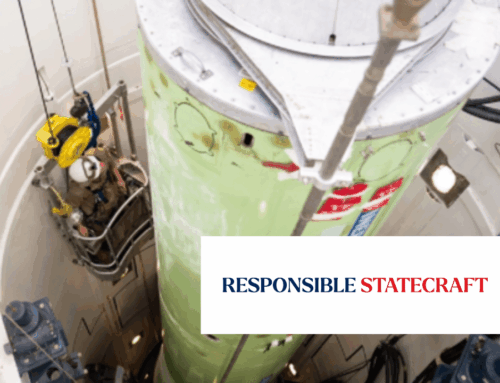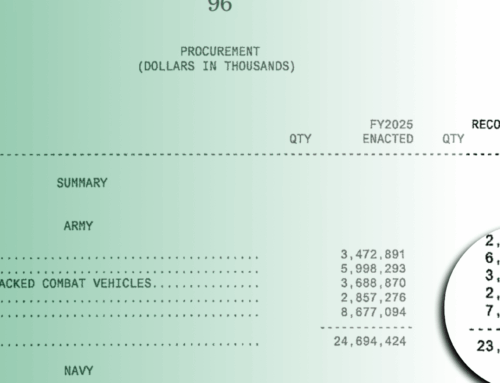Last week, the Navy awarded a $950 million contract to BlueForge Alliance, a Texas-based non-profit, to help recruit workers for the submarine industrial base. This sector has been contending with workforce shortages that have delayed submarine production. Options on the contract could push its total value over $980 million. According to the Navy, the contract was not competitively awarded, because no other source could meet the agency’s requirements.
We have some questions.
First, the cost. To put this into perspective, a 30-second Super Bowl commercial in 2024 cost $7 million. So, what exactly is the Navy buying with nearly $1 billion? The answer seems to be a job board website at buildsubmarines.com, complete with a homepage video of submarine workers and an email sign-up form. Essentially, it consolidates job openings across the submarine industry into one place.
According to Breaking Defense, as of June 2024, the Navy had already awarded $500 million in contracts to BlueForge since its founding in November 2022. Much of that funding has gone towards expensive advertising campaigns and sponsorships—ranging from NASCAR to the MLB season opener and the Oscars—that direct traffic to buildsubmarines.com.
Assessing the actual impact on the submarine workforce is tricky. In August, BlueForge announced that the website had received “over one million apply clicks within its career portal,” which they characterize as “a clear indication of the growing interest in skilled trades and the pursuit of purpose-driven careers.” But the term “apply clicks” suggests many of those clicks didn’t lead to actual job applications, let alone hires. BlueForge’s press release notes that since the site was relaunched in September 2023, “more than 40,000 candidates have created custom profiles, enabling them to apply for multiple positions with ease.” However, it says nothing about how many of those profiles resulted in applications or hires. BlueForge likely has this data—so why omit it from a press release meant to showcase their impact? Probably because the numbers aren’t as impressive as they’d like us to believe.
Further clouding the return on investment is the fact that BlueForge contracts have bundled workforce development with other initiatives, such as leading an additive manufacturing consortium. According to Matt Sermon, executive director of the Navy’s Program Executive Office for Strategic Submarines, the consortium brings together universities and manufacturers to focus on “the material maturity that we need…”
As for the Navy’s claim that no other source could meet its needs, we remain unconvinced. In July, the Navy, along with the Pentagon’s Innovation Capability and Modernization Office, awarded a $2.4 billion contract in July to Deloitte Consulting “for the Submarine Workforce and Industrial Base requirement… to deliver systemic, holistic solutions to regional and broader submarine industrial workforce and industrial base challenges.” That sounds remarkably similar to BlueForge’s contract “to support planning, resourcing, coordinating, and uplifting the U.S. Submarine Industrial Base and Foreign Military Sales requirements.” Together, these two contracts leave us wondering why the BlueForge contract was sole-sourced. They also highlight the growing scale of Pentagon spending to pick up the industry’s slack in workforce recruitment and other basic functions of a stable industrial base.
The Navy has set a goal of adding 100,000 new workers to the submarine industrial base over the next 10 years. Clearly, it’s investing heavily in recruitment to meet that goal. But it’s worth asking: why should it have to? Submarines are a national security priority, but shouldn’t the cost of hiring the workforce to build them be included in the cost of the submarines themselves?
With all the caterwauling about industrial base challenges from submarine builders like Huntington Ingalls Industries (HII) and General Dynamics Electric Boat, one might think these companies are strapped for cash, necessitating a taxpayer bailout just to hire the workers they need to build their products.
Financial data, like stock buybacks that boost shareholder profits and executive compensation packages, tells a different story. In January 2024, HII announced an additional $600 million in stock buybacks. General Dynamics bought back $139 million of its stock through the first two quarters of the year. On a May 24 earnings call, General Dynamics’ CEO predicted that “the cash performance for the remainder of the year is going to be very strong and we will act accordingly,” foreshadowing even more buybacks to come. Apparently, Navy Secretary Carlos Del Toro’s earlier admonition to the industry—urging them to invest in industrial capacity—fell on deaf ears.
Setting aside why taxpayers are on the hook for this at all, there’s simply not enough publicly available information to tell if this nearly $1 billion contract with BlueForge will produce a good return on investment or why it was a sole-source award. Policymakers at the Pentagon, specifically those at the Defense Contract Audit Agency (DCAA) and the Office of the Navy Inspector General, should seek to address that, as should lawmakers in Congress. If the Pentagon insists on spending taxpayer dollars to bail out companies that can’t retain enough workers because they’ve prioritized profits over production, taxpayers at least deserve transparency on how the money will be spent and what we’ll get in return. And while they’re at it, policymakers need to find a better way to make Pentagon contractors cover their own expenses than the occasional finger wag when they spend billions on stock buybacks.










